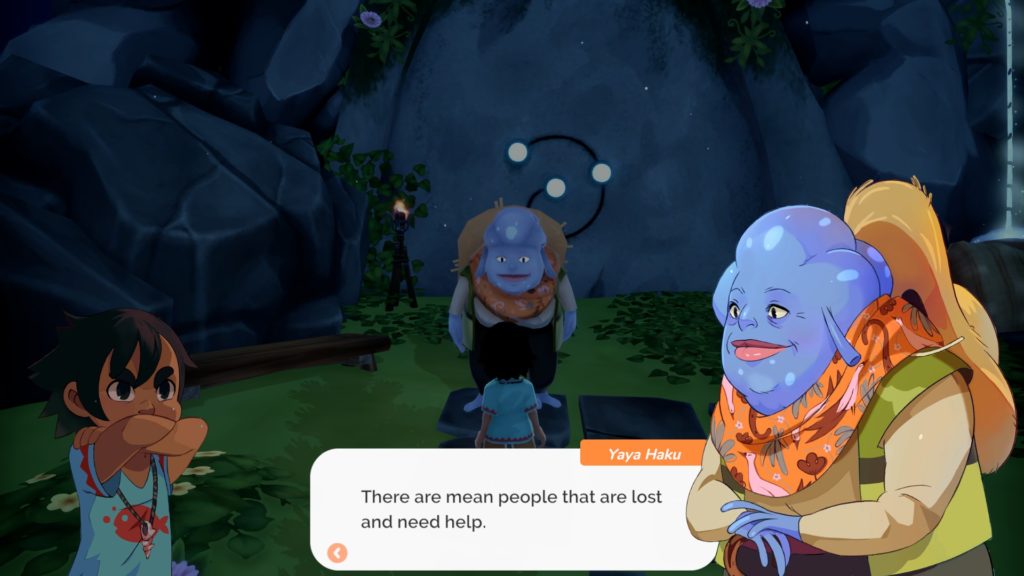Summer in Mara begins on an island on the titular ocean world of Mara. You take on the role not of a great hero, royalty, or adventurer, but of a little girl named Koa. Abandoned in a shipwreck and taken in by Yaya Haku an elderly, sole inhabitant of a remote island, Koa grows up learning and practicing stewarding care for Mara. This is not an easy lesson and Koa will soon discover that Mara not only gives, she takes, too.
It is not long into your experience that not everything is idyllic as Koa’s newfound home. Yaya Haku dies, leaving a little girl on a remote island by herself. She must remember everything that was passed along to her or she, too, will perish. What unfolds from here is a series of events that lead Koa from her island home and into an unfamiliar world filled with more people than she even knew existed on Mara.

The gameplay loop within Summer in Mara is fairly simple. Along your journey, you will meet people and those people have tasks that will require the building, planting, fetching fish, or discovery of something in order to progress their stories forward. You are typically rewarded with items, recipes, or blueprints which will allow you to develop your island better and progress other stories. However, Koa needs to eat and sleep well in order to keep up her energy and to be productive the next day!
Because of this gameplay loop, your actions within the course of a day are very limited and some actions necessary to progress the narrative just take time. This draws outpacing, which can be a bit of a double-edged sword. The place where pacing turns from fun to frustrating is in the unpredictable growth of some plants… specifically, bananas. Now, that does not sound like a big problem until you need a ridiculous amount of them to progress the story. Had I known this ahead of time, I would have planted them earlier in the game. Because of that, it took me an extra two or three in-game weeks to move forward. Perhaps, this was a lesson in child-like impatience.

Speaking of child-like things, what developer Chibig captured so well within Summer in Mara is that each new situation Koa finds herself in is navigated with child-like simplicity, wonder, and stubbornness. In some situations, there are adults that you interact with that would take advantage of this innocence. For example, one character repeatedly sends Koa on missions to retrieve items for her overworked employer, but ultimately takes credit for acquiring them herself. There are moments where you see mistrust develop, but you also see the growth of character and conviction as Koa becomes a part of a greater story. You get a front-row seat to seeing lessons that Koa learns sink in as she develops relationships with people throughout her world.

Summer in Mara feels like a mash-up between The Legend of Zelda: The Wind Waker and My Time In Portia. It has a charming mixture of bright colors and whimsical music that encapsulates the world you are immersed within. Navigating Mara via boat while searching for treasures, messages in bottles from Kickstarter backers, and gathering materials to build up your island was a largely enjoyable experience even if the story seemed a bit predictable at times.
Even with all of the exploration, it is a slower-paced game with a gameplay that might get stale for some players quickly. If you are going to get into this game, know that you are here for a journey, not a destination. This experience took me around 25 hours to complete.

If you are looking for a slower-paced title that presents a gaming experience from a point of view that is often lost to us in the cynicism of adulthood, Summer in Mara provides some incredible reminders of the power of child-like faith – even in people who we deem unworthy of it. May we all have a little bit of Koa’s simplicity, wonder, and stubbornness in us all!
Summer in Mara is available on Steam and Nintendo Switch for $24.99.
Note: Our review of Summer in Mara was performed on Steam with a code from PR.
COMPARE TO: The Legend of Zelda: The Wind Waker, My Time In Portia







